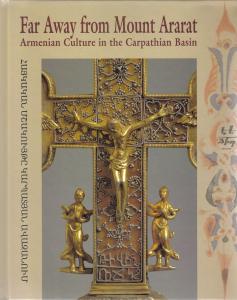
Far Away from Mount Ararat. Armenian Culture in the Carpatian Basin
Far Away from Mount Ararat
Armenian culture in the Carpathian Basin. A joint exhibition of Budapest History Museum and National Széchényi Library, 5 April 2013 – 15 September 2013
The exhibition was organized and the catalogue edited by Bálint Kovács and Emese Pál
NSZL–Budapest History Museum, Budapest, 2013., 184 pages
ISBN 978 963 200 608 6
This is the illustrated bilingual (Hungarian and English) catalogue of the 2013 joint exhibition of Budapest History Museum and National Széchényi Library entitled Far Away from Mount Ararat. Armenian culture in the Carpathian Basin with ten related academic studies included.
The events organized by the two institutions belong to the worldwide series of exhibitions and conferences that marked 500 years of Armenian book printing, commemorating that in 1512-13, typographer Hakob Meghapart published the first book printed completely with Armenian letters, Urbatagirk (The Book of Fridays). Armenian written culture had a special place in our exhibition, too, but the items displayed covered a much wider scope, including treasures of ecclesiastic art of Transylvanian Armenians and precious and rare Armenian-related artworks from Hungarian public collections.
A major influx of Armenians reached the Carpathian Basin in the 17th century. They settled first in Transylvanian towns Szamosújvár, Gyergyószentmiklós, Erzsébetváros and Szépvíz, then they spread to the whole Carpathian Basin, mixing the heritage of their homeland with the culture in place. Armenians built up valuable libraries and other collections of books and left to posterity treasures of art still unknown not only for the locals but in fact also for the academic circles. The oldest items of our exhibition come from the collections of 18th century Transylvanian churches, and have never been exhibited abroad before. These collections contain unique volumes like the world’s first Bible in Armenian, but apart from them, we present books from almost all the old Armenian printing presses in Constantinople, Venice, Rome, Marseille, Vienna, Trieste, Saint Petersburg, Amszterdam, etc.
Shopping
Our publications are available in our bookshop, or can be ordered from the Publications Department of the NSZL using the contact details below: Főigazgatói Kabinet kiadványtára, Országos Széchényi Könyvtár, 1276 Budapest P.O. box 1205., phone: 06 1 232-3556, e-mail: kiadvanytar@oszk.hu.




